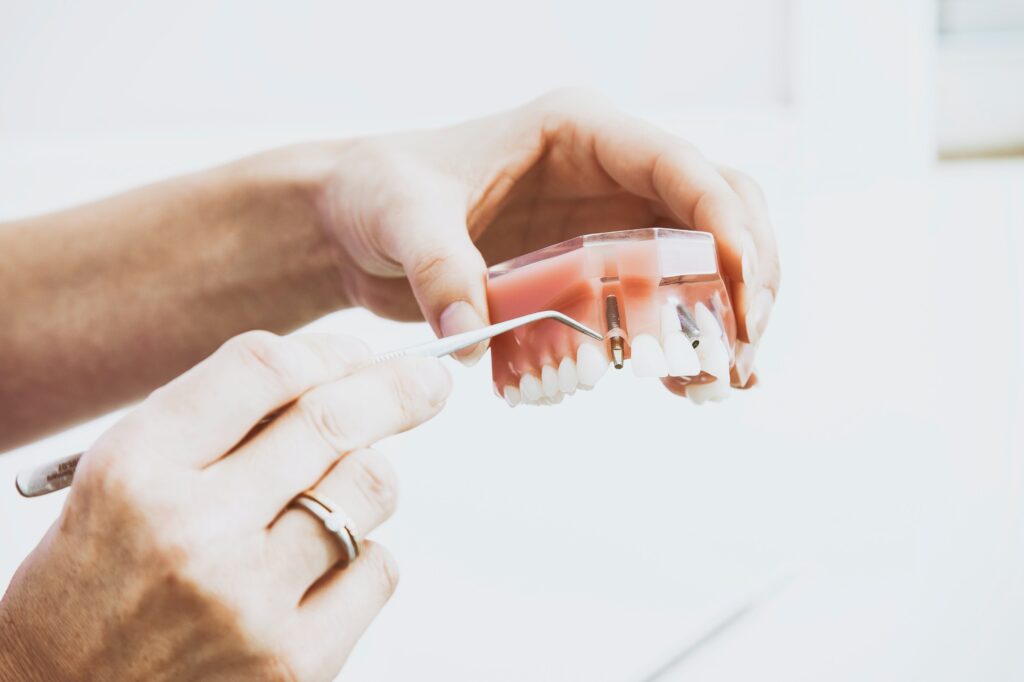Published: 07/05/2023

If you’ve experienced the loss of a tooth (or several), you’re not alone. In fact, a mere 48% of American adults (ages 20 to 64) still have a full set of their permanent teeth. And for seniors (over 65 years old), nearly one in five have lost all their teeth. If left untreated, losing teeth can negatively impact chewing patterns, nutrition, self-esteem, and other health conditions, explaining why dental implants have grown in popularity.
Causes of Tooth Loss
People can lose teeth for many different reasons, including:
- Genetics, which may include a malformation of the jaw bone, cleft palate, Down syndrome, or when some adult teeth never form in the first place (known as hypodontia, oligodontia, and anodontia, depending on how many teeth are affected).
- Gum disease, such as gingivitis or periodontitis, which leads to pockets (i.e., spaces) between teeth that cause tooth and bone decay as well as receding tissue that can lead to tooth loss as the disease progresses.
- Injuries due to sports, falls, accidents, and other traumas to the mouth. (If you do lose a tooth in an accident, you may be able to reposition it back in the socket and prevent permanent loss. Seek immediate dental help but first take steps to recover the tooth. If you aren’t able to reposition the tooth in the socket, store it in milk or hold it in your mouth next to your cheek on your way to the dentist. Avoid placing the tooth in water, a paper towel, or any chemicals. And protect the root from being touched.)
- Health conditions, including tooth decay, poor nutrition, smoking, lack of access to dental care, poor dental hygiene, diabetes, heart disease, asthma, emphysema, rheumatoid arthritis, stroke, and more.
Replacing missing teeth is clearly both a common desire and an important one to improve not only your smile but your overall health.
Teeth Replacement Options
No matter why teeth are lost, it is possible to restore your smile and improve your bite.
False teeth have been a long-standing approach. There have been numerous technical advances, though, in replacing lost teeth, including dental implants, bridges, and improved dentures.
Dental implants are particularly promising to replace single teeth as they can replace the lost tooth with a permanent tooth that blends seamlessly (and comfortably) into your existing teeth.
The process, however, involves multiple steps, including:
- CT (computerized tomography) and other imaging to evaluate the jaw health and ensure the jaw bone is strong enough to support the implant.
- Augmentation is only needed if the jawbone needs additional support for the implant. A surgical procedure adds bone or bone-like material to the jaw. After the procedure, it can take several months to fully heal and move on to the next step.
- Titanium screw placement to mimic the new tooth’s root. Again, it can take several months for the area to fully heal and ensure the screw and bone adhere.
- The final step is when the crown or false tooth, designed to fit the contours and color of the surrounding teeth, is placed.
With proper care, the new tooth can last 10, 15, or even 20+ years into the future.
If you’ve lost a significant number of teeth, though, dental implants may become too costly and invasive. Dentures may be more appropriate. There are two types of dentures available:
- Partials, which are worn in place of a few missing teeth
- Full or complete dentures, which replace an entire row of teeth on the upper or lower jaw.
Dentures are only worn as needed and are removed during sleep. They also require upkeep, including daily cleaning and avoiding some foods and drinks.
Between these two popular options are dental bridges. They can also replace multiple missing teeth. They’re attached via a bracket (aka bridge) and cemented to either healthy teeth or implants. While bridges typically take less time and are less invasive than implants, you’ll still need several appointments for:
- Imaging and taking an impression of the surrounding teeth to ensure the bridge fits comfortably and promotes a healthy bite.
- Support building for the surrounding teeth. For instance, crowns may be added to the supporting teeth, or dental implants may be needed to secure the bridge. During this time, you’ll also be fitted for a temporary bridge to wear until the permanent bridge is completed.
- Finally, the permanent bridge will be cemented into the correct place, though you may also need follow-up appointments to make adjustments and ensure the bridge is ideally positioned.
Why Dental Implants Are a Popular Option
Dental implants are the next best option to real teeth. They’re designed to look, feel, and even function as well or better than your real teeth. This can increase not only your confidence but help improve health conditions. Plus, dental implants:
- Look and feel natural and fit comfortably, so you can continue living a full, happy life.
- Are long-lasting as long as they’re properly cared for.
- Have a high success rate and tend to last longer than other options.
- Help improve your ability to chew and move your mouth naturally, which can help prevent malnourishment and allow you to speak clearly.
- Support the jawline, so it remains stronger to promote the health of the surrounding teeth and gums.
If you, like most Americans, have experienced the loss of a tooth or several teeth, there are several treatment options. The negative impacts of missing teeth can be highly underestimated and go far beyond just cosmetics or looking good and feeling confident. Reach out us to discuss the best option for dental implants to suit your specific condition and lifestyle.
Talk to Us About an Appointment